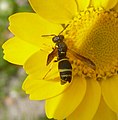Dosya:Odynerus spinipes^ Vespidae. See parasite note - Flickr - gailhampshire.jpg - Vikipedi

Bu önizlemenin boyutu: 519 × 600 piksel. Diğer çözünürlükler: 208 × 240 piksel | 415 × 480 piksel | 654 × 756 piksel.
Tam çözünürlük ((654 × 756 piksel, dosya boyutu: 166 KB, MIME tipi: image/jpeg))
Dosya geçmişi
Dosyanın herhangi bir zamandaki hâli için ilgili tarih/saat kısmına tıklayın.
| Tarih/Saat | Küçük resim | Boyutlar | Kullanıcı | Yorum | |
|---|---|---|---|---|---|
| güncel | 13.21, 14 Ekim 2017 |  | 654 × 756 (166 KB) | Chiswick Chap | Cropped 31 % horizontally and 22 % vertically using CropTool with precise mode. |
| 21.48, 8 Temmuz 2016 |  | 952 × 972 (183 KB) | Josve05a | == {{int:filedesc}} == {{Information |Description=Most Strepsiptera (also known as twisted-wing parasites) live as internal parasites of bees, wasps, grasshoppers, leafhoppers, and other members of the order Hemiptera. Only a few species that parasit... |
Dosya kullanımı
Bu görüntü dosyasına bağlantısı olan sayfalar:
Küresel dosya kullanımı
Aşağıdaki diğer vikiler bu dosyayı kullanır:
- en.wikipedia.org üzerinde kullanımı
- fa.wikipedia.org üzerinde kullanımı
- gl.wikipedia.org üzerinde kullanımı
- ja.wikipedia.org üzerinde kullanımı
- la.wikipedia.org üzerinde kullanımı


 French
French Deutsch
Deutsch